|
 |
 |
|
|
|
|
Christianity
|
| |
|
Dr.
Marguerite Connor
|
|
Christianity
means a belief in the divinity of Jesus Christ.
follower of the doctrines
associated with Him is called a Christian.
|
| |
 Major Churches: Catholicism,
Protestantism, Other Major Churches: Catholicism,
Protestantism, Other
 Universal Christian Beliefs Universal Christian Beliefs
|
| |
 Major Churches Major Churches |
| |
|
Catholicism
|
Protestantism
|
Other
|
- Roman
- Orthodox
- Eastern Rite
|
- Lutheran
- Presbyterian
- Anglican (in England)
- Episcopalian(elsewhere)
- Baptist
- Methodist
- Southern Baptist (in
USA)
- Fundamentalist
- Charismatic
- Quaker
- Unitarians
- Mennonites
- Dutch Reformed Church
Old branches:
- Puritan
- Anabaptist
- Shaker
- Calvinist (splintered)
|
- Church of Jesus Christ
of the Latter Day Saints (Mormon)
- Jehovah''s Witness
- The Church of Christ
Scientist (Christian Scientists)
|
|
|
TOP
|
 Catholicism Catholicism |
 |
Left:
Christian rosary used in prayer (Langley)
Three Major
Groups: Roman, Orthodox and Eastern Rite
This
discussion will focus on Roman Catholics (in the West usually simply
called "Catholics") since it is the most numerous group and they are
the ones English lit majors are most likely in need of understanding.
Major Beliefs
Major
Holidays/Seasons
|
| |
Roman
The most "famous"
and powerful section of Catholicism is
Roman Catholic, called this since the seat of
the Church is in Rome, but technically in its own country, a small
city-state called Vatican City. The leader of this branch of
Catholicism is called The Pope, currently Pope John
Paul II. Until 1963, all Roman Catholic services and
communications were done in Latin. Usually in the West, references to The
Church (capitalized) mean The Roman Catholic Church. For
almost 1500 years it was the only major Western Christian group, so it
was The Church. It is also referred to in some literature as Holy
Mother Church, a reflection of the love and the
relationship Catholics envision to have with their church.
Orthodox
An early split in
Catholicism created the Orthodox churches in countries
which were once part of the Byzantine Empire, the most famous of which
are the Greek and Russian Orthodox Churches. They are
headed by Metropolitans, and services are held in the national language
of the Church, so a Greek Orthodox service in the United States would
still be in Greek.
Eastern Rite
A hybrid of
these two are the Eastern Rite Churches. These are
technically Roman Catholic, since they follow the dictates of the pope,
but they use a form of worship closer to the Orthodox Church, and are
associated with an Eastern European country, i.e., Ukrainian
Church.
 A
marriage in an Eastern Orthodox Church. The priest holds the
wedding crowns over the heads of the bride and groom. (Parrinder 437)
A
marriage in an Eastern Orthodox Church. The priest holds the
wedding crowns over the heads of the bride and groom. (Parrinder 437) |
The Inside of a
Romanian Church
from Online Icons
|
BACK
TOP
|
| |
| |
Major
Beliefs
These are the beliefs that make
Roman Catholicism what it is:

|
- The most "controversial"
and the real "acid test" between Catholics and Protestants is the
teaching of transubstantiation, a Catholic
belief that during the communion (eucharist) ceremony, the bread and
wine actually becomes the body and blood of Jesus Christ.
- The
infallibility of the pope on matters of doctrine
(called "speaking ex cathedra"‥)
The
doctrine of transubstationation has aroused great controversy over the
centuries. (Parrinder
428) |
|
|
The
Immaculate Conception of Mary (means that she was born without
"original sin"--the sin humans carry from Adam and Eve''s first
disobedience). This is often confused with the Virgin Birth of
Jesus. This is the belief that the Holy Spirit made Mary
pregnant,
"The Virgin of the
Grotto"
at Lourdes, France.
The Virgin Mary is said to have appeared to St.
Bernadette 18 times in 1858 and to have revealed to her a spring whose
waters have the power of curing ills. (Langley 165)
|
- Sacraments
are special events in Catholics lives when God sends special grace.
Catholics recognize seven: baptism, communion, confession,
confirmation, marriage, holy orders, and anointing of the sick
(this used to be called "Extreme Unction" and was used
when a person was dying, but it was opened up to the ill in the late 20th
century).
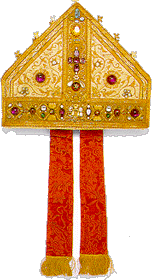
- The Catholic Church system is
hierarchical. For Roman Catholics ranking goes pope,
cardinals, bishops, priests. There are also subdivisions with
bishops and priests, but we needn''t go into that here.
Left:
Bishop''s mitre (Langley)
- Sainthood is
something special in Catholicism (and for some Protestant groups as
well). But for Catholics, there is a special, official process the
Church uses to call someone a saint. This can be confusing to
non-Catholics, but if someone gets named an official Saint, they were
most likely better than I''m ever going to be.
- There are also Patron
saints of just about everything and everywhere. These are
not gods and goddesses as my polytheistic students often think, but a
saint who takes special interest in the needs of the group he or she
represents and then is willing to intercede with God for special
intentions. Important ones for English majors:

|
The Blessed Mother
- Patron of China
St. George
- Patron of England
St. Patrick, St.
Brigid, St. Columba - Patrons of Ireland
St. Andrew
- Patron of Scotland
St. David
- Patron of Wales
The Immaculate
Conception - Patron of USA
St. Cecelia
- Patron of music
Left: St. Patrick Patrick is invoked
against snakes and is often portrayed driving them before him. (Langley 94)
Right: St. Cecelia The Angel in this romanticized portrayal of
Cecilia is holding the roses that are one of her emblems. (Langley 125)
|

|
BACK
TOP
|
| |
| |
Major
Holidays/Seasons
Advent
is the four week period before Christmas, a time
for preparation for the birth of Jesus. During this times traditional
Catholics often light the Advent Wreath: three purple candles
and one pink. For the first three Sundays of Advent a purple
candle is lit, and on the fourth Sunday the pink is lit. These are
often decorated beautifully and build the anticipation for
Christmas.
Lent
is the 40 days before Easter. It is a time of repentance,
sacrifice and preparation for the coming holiday. It
starts on a day called Ash Wednesday, a day many
Christian groups, not just Catholics, have their forehead marked by
ashes in the sign of the Cross. (T.S. Eliot mentions this day in a
famous poem of the same name.)
Also See Christmas
and Easter.
BACK
TOP
|
| |
|
|
| |
|
|
 Universal
Christian Beliefs Universal
Christian Beliefs |
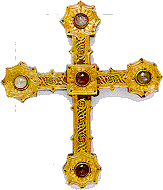 |
I''m using the term "universal"
loosely here. There are so many Christian groups that somewhere
there''s going to be a group that disagrees with something. But I''ve
tried to include major concepts that are relatively common to all
Christians and will be helpful in understanding literatures in English.
Dr. Marguerite Connor
|
| |
The Creeds
While many of the different
Christian churches have their own creeds (or statement of beliefs),
there are two which are relatively universal, the Nicene Creed
and the Apostle''s Creed.
The Nicene Creed
Written during the 4th century in
an attempt to unify Christians, this creed was named after the first
ecumenical council of Nicea (325). It was adopted by the Christian
church in 451. Its central doctrines are those of the Person of Jesus
Christ and the reality of the Holy Spirit. It is the only creed
accepted by all three major branches of Christendom including
Protestant, Roman Catholic and Eastern Orthodox Christians.
The Nicene
Creed
We believe in
one God the Father Almighty, Maker of heaven and earth, and
of all things visible and invisible.
And in one Lord
Jesus Christ, the only-begotten Son of God, begotten of
the Father before all worlds, God of God,
Light of Light, Very God of Very
God, begotten, not made, being of one
substance with the Father by whom
all things were made; who for us men, and
for our salvation, came down
from heaven, and was incarnate by the
Holy Spirit of the Virgin Mary, and
was made man, and was crucified also for
us under Pontius Pilate. He
suffered and was buried, and the third
day he rose again according to the
Scriptures, and ascended into heaven, and
sitteth on the right hand of the
Father. And he shall come again with
glory to judge both the quick and the
dead, whose kingdom shall have no end.
And we believe
in the Holy Spirit, the Lord and Giver of Life, who
proceedeth from the Father and the Son,
who with the Father and the Son
together is worshipped and glorified, who
spoke by the prophets. And we
believe one holy catholic and apostolic
Church. We acknowledge one
baptism for the remission of sins. And we
look for the resurrection of the
dead, and the life of the world to come.
Amen.
|
The Apostles'' Creed
The Apostles'' Creed was
developed between the second and ninth centuries as a baptismal creed
for new Christians. It is the most popular creed used in worship
by Western Christians. Its central doctrines are those of the Trinity and God the Creator.
According to legend, the Apostles (Christ''s 12 main followers) wrote
this creed on the tenth day after Christ''s ascension into
heaven. That is not the case, though the name stuck.
This is the modern English
version:
The Apostles''
Creed
I believe in
God, the Father almighty, creator of heaven and earth.
I believe in
Jesus Christ, God''s only Son, our Lord, who was conceived by the Holy
Spirit, born of the Virgin Mary, suffered under Pontius Pilate, was
crucified, died, and was buried; he descended to the dead. On the third
day he rose again; he ascended into heaven, he is seated at the right
hand of the Father, and he will come again to judge the living and the
dead.
I believe in
the Holy Spirit, the holy catholic church, the communion of saints, the
forgiveness of sins, the resurrection of the body, and the life
everlasting. AMEN.
|
BACK
TOP
|
| |
| |
The
Bible
 Book
Cover. The cover of a gospel book encrusted with jewels
and ivory cameos
presented
by Pope Gregory the Great to a Lombard queen around the year 600.
(Lerner n.p.)
Book
Cover. The cover of a gospel book encrusted with jewels
and ivory cameos
presented
by Pope Gregory the Great to a Lombard queen around the year 600.
(Lerner n.p.)
The Bible is the name of
Christian''s holy book. "Book" is a misnomer, since it is
actually comprised of many books. It has two main parts: The
Old Testament, which is the books of the Jewish
Pentateuch (these are the five books supposedly written by
Moses: Genesis, Exodus, Leviticus Numbers and Deuteronomy)
as well as more books that tell the story of the Jewish people.
This is important to Christians for Jesus was a Jew, and his coming was
seen as a way to spread the covenant between God and the Jews to all
other peoples. (See Contents
of the Bible.)
Not all Christian groups agree on
exactly how many books belong to the Old Testament (this is called
being canonical), but included in all groups are the majestic poetry of
the Psalms; the beautiful love poetry of "The
Song of Solomon"; and the prophecies of the
coming Messiah.
The Apocrypha
are fourteen books of the Bible included in the Vulgate version of the
Bible (the authorized Latin version of the Bible used by the Roman
Catholic Church), but considered uncanonical by some Protestant
groups. The Deuterocanonicals are 15 books accepted by the Roman
Catholic Church as canonical. These two groups overlap, so
combined there are 15 in all. For most people other than
scholars, the issue of "canon" is an obscure part of the history of the
Church''s struggles and need not be a problem.
The New Testament
is comprised of the books that are the fulfillment of the promises of
the Old Testament. The first four books are the most sacred and
important part of the Bible, The Gospels.
Traditionally written by four inspired authors, Matthew, Mark,
Luke and John, these books tell the story of the Angel
Gabriel''s annunciation to Mary, the birth of Jesus, His life and
miracles, His ultimate crucifixion and resurrection, and His final
ascension into Heaven.
The New Testament also includes a
book about the actions of the apostles and the early church in the
years following Jesus''s resurrection, and the epistles (or letters) of
several of the apostles, but mostly Paul, to early Christian groups.
The last book of the Bible is a very mystical book called "The
Revelation to John" (or Revelations), which relates a dream of
the end of the world sent by God to John.
Contents
of Bible
|
OLD
TESTAMENT
Genesis
Ecclesiastes
Exodus
Song of Songs
Leviticus
Isaiah
Numbers
Jeremiah
Deuteronomy
Lamentations
Joshua
Ezekiel
Judges
Daniel
Ruth
Hosea
1
Samuel
Joel
2
Samuel
Amos
1
Kings
Obadiah
2
Kings
Jonah
1
Chronicles
Micah
2
Chronicles
Nahum
Ezra
Habakkuk
Nehemiah
Zephaniah
Esther
Haggai
Job
Zechariah
Psalms
Malachi
Proverbs
DEUTEROCANONICALS/APOCRYPHA
Tobit
Susanna
Judith
Bel and the Dragon
Esther
(Greek)
1 Maccabees
Wisdom of
Solomon
2 Maccabees
Sirach
Some Additional Books
Baruh
1 Esdras
Letter of
Jeremiah
2 Esdras
Song of the Three Young
Men
The Prayer of Manasseh
NEW
TESTAMENT
Matthew
1 Timothy
Mark
2 Timothy
Luke
Titus
John
Philemon
Acts
Hebrews
Romans
James
1
Corinthians
1 Peter
2
Corinthians
2 Peter
Galatians
1 John
Ephesians
2 John
Philippians
3 John
Colossians
Jude
1
Thessalonians
Revelation
2 Thessalonians
|
BACK
TOP
|
| |
|
| |
The
Trinityis a common belief
with almost all Christians, and the hardest for many non-Christians to
understand, especially people from polytheistic cultures.
For Christians, God has three
"faces": God the Father, God the Son and God the Holy Spirit. They are
three-in-one and one God only.
The Father is the Creator of Heaven and Earth and all of
the Universe. We use He as a bit of a shorthand and to help human
conceptualize him, but he is genderless, both male and female, and
beyond human comprehension.
The Son is Jesus, true man and true god, born of a
woman, Mary, in Bethlehem around 2000 years ago. He is the Savior of
humans, sometimes called "The Redeemer," and became incarnate to help
humans "see" God. He also was crucified to redeem the sins of
humans, but triumphed over Death and rose again three days later. (see 3-5).
The Holy
Spirit (or in early
literature, the Holy Ghost) is just that, the spirit of God.
Sometimes called "The Revealer,"‥ it is as The Spirit that God comes to
people to help. According to Christians, when the Gospels were being
written, the writers were inspired by the Holy Spirit. And it was the
Holy Spirit which impregnated Mary. This aspect of God is often
depicted as a dove, or a dove with a flaming heart or head in much
Christian art.
BACK
TOP
|
| |
|
| |
The
Eucharist
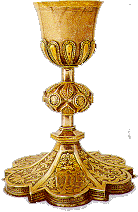 Cup
of Suffering
(Langley 50)
Cup
of Suffering
(Langley 50)
|
This is the central rite
of Christian celebration and is also called The Lord''s Supper or Communion. During this ceremony bread
and wine (or grape juice in some groups) are consecrated by a minister
or priest and eaten by the congregation. This is done at the order of
Jesus, who said at the Last Supper, "Do this in
remembrance of me."
For the Catholic Churches
as well as some Protestant Churches this is regarded as a sacrament
which symbolizes and effects the union of Christ with the
believers.
The early Christians ate meals in remembrance and believed that Christ
was present in the breaking of the bread. Early theologians
accepted Christ''s statements "This is my body"
and "This cup !K is the new covenant in my blood"
as the explanation of the transformation of the bread and wine into
body and blood. This is called transubstantiation.
In the 16th
century, Protestant reformers offered several different views on this
including the doctrine of consubstantiation.
|
BACK
TOP
|
| |
|
| |
Two
Major Holidays
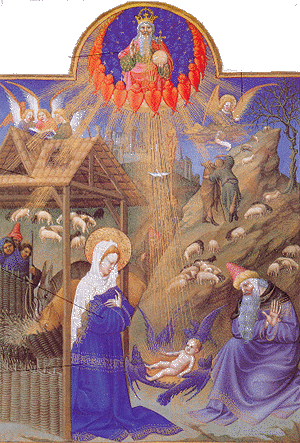
|
- Christmas (December 25) is the
celebration of the birth of Jesus Christ. Of course, this is
also the time of Christmas trees, cards, gifts and parties, but at
heart, it is a religious holiday. Many Catholics like to go to the
traditional Midnight Mass (Mass is what Catholics
call their religious service) and then gather with family afterwards.
Right: Picture showing the story of Christ''s birth, from a
15th-century book. The painting shows the dress and styles of the
time when it was painted.
Topmost: God the father watches from heaven, holding the world in his
hand and worshipped by angels.
Second to the
top: Angels announce the birth to surprised local shepherds.
Front: Mary and
Joseph dressed in blue, the colour of divinity and heaven.
|
- Holy
Week starts on the Sunday before Easter on a day called Palm or
Passion Sunday. This day commemorates Jesus''s
triumphant entrance into Jerusalem at the beginning of his final week
on earth.
Other major days are Holy Thursday (the day of the
Last Supper), Good Friday
(the day Jesus died) and Holy Saturday. Finally
comes Easter Sunday,
the day all Christians celebrate Jesus's triumph over death and His
resurrection to life. Catholics celebrate with Mass (often at
dawn) and then family gatherings. This is the major holiday for all
Christians, including, of course, Catholics.
|
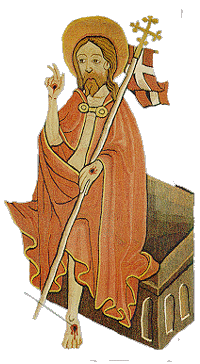
|
BACK
TOP
|
| |
|
| |
The
Virgin Birth |
| |
Christians believe
that Mary, a pious
unmarried Jewish girl, was the mother of Jesus and that his "father"‥
was the Holy Spirit. She was a virgin when her Son was born, but
she married Joseph
before her son was born. Joseph was a pious Jewish carpenter who in a
dream was told not to repudiate his pregnant fiance. He brought up
Jesus as his own son, and is called St.
Joseph by most Christians.

Annunciation In
Leonardo da Vinci''s painting Mary is sitting in a garden when Gabriel
appears to her; outdoor settings were common in Italian Renaissance
art. (Hallam 60)
Catholics believe that Mary
remained a virgin for the rest of her life, but Protestants, relying on
Biblical references to Jesus''s brothers, believe that she went on to
have other children with Joseph. But both groups agree that she
was a virgin when she gave birth to Jesus.
BACK
TOP
|
| |
|
Picture source:
1. Parrinder, Geoffrey, ed. World
Religions: From Ancient History to the Present. New York:
Facts on File, 1971.
2. Langley, Myrtle. Religion
(Eyewitness Guides.) New York: Dorling Kindersley, 1996.
3.
Hallam, Elizabeth, ed. Saints. New York:
Simon & Schuster, 1994.
4. Lerner, Robert E. et al. Western
Civilizations: Their History and Their Culture. 12th
Ed. New York: Norton, 1993.
|
|
|
|
|
